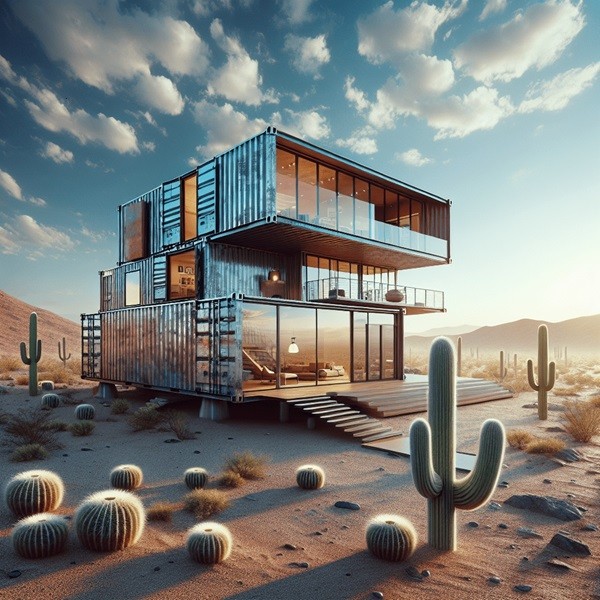
Key Takeaways
- Discover the types of zoning laws in Arizona that impact shipping container home construction.
- Learn the step-by-step process for obtaining the necessary permits for your container home.
- Find out how to evaluate your property for container home eligibility.
- Understand the importance of community engagement and adhering to building codes for your project.
Unlock the Potential of Shipping Container Homes in Arizona
Imagine a home that is not only cost-effective and environmentally friendly but also uniquely yours. Shipping container homes offer just that—a canvas for creativity and a sustainable housing solution. Arizona’s landscapes, from the bustling streets of Phoenix to the tranquil deserts, provide the perfect backdrop for these innovative abodes. But before you dive into building your dream container home, it’s crucial to understand the lay of the land, specifically Arizona’s zoning laws and permit requirements.
Benefits of Choosing a Shipping Container Home
Shipping container homes are more than a passing trend. They come with a host of benefits:
My Favorite Container Homes Resource
I compared the top 3 Container Home Guides
to discover the ultimate resource!
See my top recommendation here
- Cost-Efficiency: Often more affordable than traditional homes, they allow for significant savings in construction and materials.
- Speed of Construction: With the right planning, a container home can be built much faster than conventional houses.
- Sustainability: Reusing shipping containers as living spaces is a form of recycling that reduces the demand for new construction materials.
- Flexibility: These homes can be modified, expanded, or relocated with relative ease.
- Durability: Designed to withstand harsh conditions, shipping containers are robust and can provide a sturdy home.
Deciphering Arizona’s Zoning Laws for Container Homes
Arizona’s zoning laws can seem like a maze, but don’t let that deter you. Your local planning department is the starting point for unraveling the zoning requirements for your shipping container home. They’ll provide the information on what’s permissible and the specific criteria your home must meet.
Zoning Classifications and Container Homes
Zoning laws are typically divided into categories such as residential, commercial, and industrial. For container homes, residential zoning is most relevant. Within residential zones, there are often further subdivisions, such as single-family or multi-family, which can impact the approval of your container home project.
Navigating Residential Zoning for Your Container Home
When you’ve found a potential site, check its zoning classification. If it’s zoned for residential use, you’re on the right track. Next, look into the following:
- Setbacks: These are the minimum distances your home must be from property boundaries, roads, and other structures.
- Height Restrictions: There may be limits on how tall your container home can be.
- Density Regulations: This refers to how many dwellings are allowed per unit of land.
Remember, zoning laws are in place for a reason. They help ensure that the community develops in an organized, safe, and aesthetically pleasing manner. Therefore, adhering to these laws is not just about compliance; it’s about contributing positively to your neighborhood.
Permit Me Please: Navigating Arizona’s Permit Landscape
After ensuring your container home plans align with local zoning laws, the next step is securing the necessary permits. This process can be daunting, but with a methodical approach, you’ll navigate it like a pro.
Stages of the Permitting Process
Here’s a breakdown of the typical stages:
- Pre-application: Before submitting your formal application, you might have a preliminary meeting with planning officials to discuss your project.
- Application Submission: You’ll need to submit detailed plans of your home, including site plans, floor plans, and elevations, along with the application forms and fees.
- Review: The planning department will review your application to ensure it meets all zoning and building codes.
- Approval: If your plans comply, you’ll be granted a permit to build. If not, you may need to make revisions and reapply.
Because building a home is a significant undertaking, the permit process is in place to protect you and your community. It ensures that your home is safe and structurally sound.
Required Documents for a Successful Application
When you’re ready to apply for a building permit, having the right documents on hand is essential. You’ll typically need:
- A completed permit application form specific to your municipality.
- Site plans showing the location of the container on your property, including distances to property lines (setbacks).
- Construction plans detailing the design and materials of your container home, including floor plans, elevations, and sections.
- Proof of property ownership, such as a deed or title.
- Any additional documents required by local codes, such as energy compliance forms or soil reports.
Each of these documents plays a role in painting a complete picture of your project for the planning department. They’re not just forms to fill out; they’re your first opportunity to show that your container home will be a safe, compliant, and attractive addition to the community.

The Checklist Before You Build
Before you can turn your container home dreams into reality, you need to check off a few important items:
- Verify the zoning for your property to ensure a container home is allowed.
- Understand the setback requirements and height restrictions.
- Assess whether the property has access to utilities like water, sewage, and electricity, or if you’ll need to make arrangements for off-grid living.
- Consider the impact of the local climate on your container home design, such as
needs and HVAC systems. - Review the property for any environmental restrictions or protected areas that might affect construction.
These checks are about more than compliance; they’re about ensuring your container home is built on a solid foundation, both literally and figuratively.
Evaluating Your Property for Container Home Eligibility
Before you invest in a shipping container, it’s crucial to evaluate whether your property is suitable. Here’s what to consider:
- Topography: Is your land flat, or will you need to invest in grading or foundation work?
- Accessibility: Can heavy machinery access the site for delivery and placement of the container?
- Utilities: Are the necessary services like water, electricity, and sewage readily available or will you need to install them?
Your property’s characteristics will not only influence the feasibility of your project but also its cost and complexity.
Community Engagement and Neighbors’ Approval
Building a shipping container home in Arizona is an exciting venture that combines creativity, sustainability, and innovation. By understanding and navigating the zoning laws and permit requirements, you can turn your vision into a reality. Remember, the journey to building your container home is as important as the destination. Stay informed, stay compliant, and most importantly, enjoy the process of creating a space that’s uniquely yours.

Ensuring Your Container Home Is Above Board
As we wrap up this guide on Arizona’s zoning laws and permit requirements for shipping container homes, let’s address some frequently asked questions that might still be on your mind.
Can I Build a Shipping Container Home Anywhere in Arizona?
While shipping container homes can be built in many parts of Arizona, not every location permits them. Always check with local zoning authorities to ensure that your chosen site allows for container homes. Certain residential areas may have restrictions or may not permit them at all.
Are Shipping Container Homes Considered Permanent Structures?
Yes, shipping container homes are often considered permanent structures and must adhere to the same building codes and zoning regulations as traditional homes. This includes obtaining the necessary permits and passing all required inspections.
What Are the Most Common Hurdles When Applying for a Permit?
The most common hurdles when applying for a permit include:
- Navigating the complex zoning laws and ensuring your project complies with all local ordinances.
- Providing all the required documentation, which can be extensive and must be accurate and complete.
- Meeting the specific building codes for safety, which may require adjustments to your original design.
Being well-prepared and informed can help you overcome these challenges more smoothly.
How Can I Ensure My Shipping Container Home Is Sustainable?
To ensure your shipping container home is sustainable, consider the following:
- Insulate your home properly to reduce energy consumption, especially in Arizona’s extreme temperatures.
- Install energy-efficient windows and doors to minimize heat gain and loss.
- Consider solar panels or other renewable energy sources to power your home.
- Use low-VOC paints and sustainable materials for interior finishes.
- Plan for water conservation with fixtures that reduce usage and consider rainwater harvesting systems.
Sustainability not only benefits the environment but can also lead to cost savings in the long run.
Can I Modify a Shipping Container Without a Permit?
Modifying a shipping container without a permit is not recommended. Most structural changes, such as cutting openings for windows or doors, require a permit to ensure the safety and structural integrity of the home. Always check with your local building department before making any modifications to your container.





